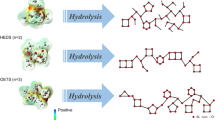Abstract
Kinetic expressions have been developed for the initial phase of the reactions between ozone and methyl-β-D-glucopyranoside, a model compound for cellulose, in aqueous solutions at moderately low pH (pH 3) and ambient temperature. Ozone is reasonably stable under these conditions. The reaction is first order in the glucoside and ozone, second order overall. Kinetic and analytical data suggest that the glucoside is directly attacked by ozone to form polyoxide intermediates. The α-glucoside was more stable and was attacked by ozone exclusively at the acetal oxygen in the initial phase of the reaction. In contrast, the β-anomer was ozonized nearly twice as fast, and was attacked by ozone mainly at the C-H bond of the anomeric carbon. The latter reaction resulted in the formation of δ-gluconolactone, probably by way of a hydrotrioxide intermediate. The fragmentation of the intermediate could be assisted by properly oriented non-bonding orbitals of the two acetal oxygens. These stereoelectronic rules were previously proposed by Deslongchamp and coworkers on the ozonolysis of acetals in non-aqueous media. The activation energy for the reaction was 69.5 kJ/mole in both acetic and sulfuric acid solutions at pH 3. The presence of transition metal-ion, in particular Co(II) and Fe(II) ions, resulted in enhancement of both ozone decomposition and degradation of the glycoside, apparently caused by free radical reactions. In some cases, addition of acetic acid led to substantial suppression of the degradation of the glucoside.
Similar content being viewed by others
References
The U.S. Environmental Protection Agency (EPA). EPA Proposal: Effluent Limitations and Pretreatment Guidelines, and Maximum Achievable Control Technology (MACT) for the Pulp and Paper Industry.Federal Register,58 (241), 66078–66216 (December 17, 1993).
G.Y. Pan, C.-L. Chen, J.S. Gratzl, and H-m. Chang,J. Wood Chem. and Technol.,4(3), 367 (1985).
G.Y. Pan, C.-L. Chen, H-m. Chang, and J.S. Gratzl,Proc. Ist International Symposium on Wood and Pulping Chemistry, the Ekman-Days, Vol. 3, 132 (1981).
Y. Satoh, A. Ishizu, and J. Nakano,Japan Tappi,38, 74 (1984).
K.P. Kringstad, B.O. Lindgren, and S.E. Sundin. In:Chemistry of Lignification with Oxygen, Ozone and Peroxides, J.S. Gratzl, H.-m. Chang, and J. Nakano (Eds.), Uni Publishers Co., Ltd., Tokyo (1980).
C. Walling and El-Taliwai,J. Am. Chem. Soc. 95, 844 (1973).
G.H. Hill,j. Am. Chem. Soc.,70, 1306 (1948).
A.A. Katai, and C.J. Schuerch,Polymer Sci. Part A-1,4, 2683 (1966).
A.N. deBelder, B. Lindberg, and O. Theander,Act. Chem. Scand.,17, 1012 (1963).
P. Deslongchamps, P. Altani, D. Frehel, A. Malaval, and C. Moreau,Canada J. Chem.,52, 3651 (1971).
C.C. Price, and A.L. Tumolo,J. Am. Chem. Soc.,86, 4691 (1964).
R.W. Murray, W.C. Lumma, Jr., and J.W.-P. Lin,J. Am. Chem. Soc.,92, 3205 (1970).
F.E. Stay, D.E. Emge, and R.W. Murray,J. Am. Chem. Soc.,98, 1880 (1976).
F. Kovac, and B. Plesnicar,Chem. Commun., 122 (1978).
B. Ericsson, B.O. Lindgren, and O. Theander,Svensk Papperstidn.,74, 757 (1971).
Author information
Authors and Affiliations
Rights and permissions
About this article
Cite this article
Pan, G.Y., Chen, C.L., Gratzl, J.S. et al. Model compound studies on the cleavage of glycosidic bonds by ozone in aqueous solution. Res. Chem. Intermed. 21, 205–222 (1995). https://doi.org/10.1007/BF03052254
Received:
Accepted:
Issue Date:
DOI: https://doi.org/10.1007/BF03052254




